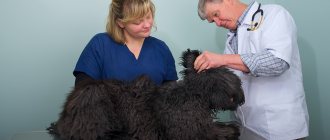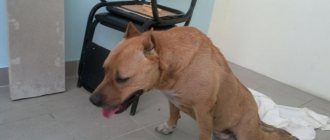Many owners who often travel with animals are familiar with the situation when driving becomes torture due to the fact that the dog gets sick in the car. Many dogs suffer from motion sickness syndrome or kinetosis. At risk are young animals with an immature vestibular apparatus. But for various reasons, adults can also suffer from painful symptoms. If your dog gets sick in the car and you don’t know what to do, then read our article. There are many ways to combat kinetosis along the way. And the sooner this fight begins, the greater the chance that the dog will feel good and the journey will be enjoyable.
How motion sickness occurs
The weakness of the vestibular apparatus lies in the imperfection of the adaptation mechanisms of the central nervous system in the puppy. This is manifested by a mismatch of impulses going to the brain from organs that record changes in the position of the body in space. These are vision, muscles and vestibular apparatus.
The vestibular apparatus is a part of the inner ear that regulates the dog's balance and is responsible for its spatial orientation. Since the vestibular system is connected to the organ of vision, it is important that visual perception corresponds to the signals coming from the vestibular receptors. The information is sent to the brain, which signals the muscles to change body position to restore balance.
Motion sickness is a consequence of the receipt of contradictory information into the brain from the eyes and vestibular receptors during movement (when the eyes record movement and the body is at rest). Spatial orientation is disrupted, the brain provides information about the stressful situation in the body. The autonomic system reacts to this condition with symptoms of a neurological, cardiovascular and digestive nature.
Useful tips
To help your dog get used to such travel faster, you should start feeding it in the car. In this case, the machine must remain in a standing position. When the animal feels calm, you can try to start the engine and again pamper your pet with something tasty. When the dog gets used to the noise of the engine, it is worth trying to start moving while continuing to feed your four-legged friend. Thus, even the most timid animals begin to react calmly to travel over time and do not experience any discomfort.
Symptoms of motion sickness
Symptoms of motion sickness resemble signs of severe poisoning of the body or intoxication. This happens because disturbances in the supply of impulses carrying information about the position of the body in space resemble the effect of toxic substances on the brain. The body's protective reaction to both of these conditions is the same.
The main symptoms are:
- severe dizziness;
- nausea and vomiting;
- cardiopalmus;
- increased salivation;
- restlessness (the dog constantly changes body position);
- weakness and lethargy.
Signs of motion sickness and first aid for a pet
During the trip, you must carefully monitor the behavior and appearance of the animal. If discomfort, restlessness, or other changes in behavior are observed, this may indicate that the dog is seasick.
Signs of kinetosis:
- the dog looks depressed, constantly licks its nose and swallows;
- may drool;
- breathing quickens;
- belching and vomiting appear;
- the pet is trembling, unable to sit still, and cannot find a comfortable position.
Only some of these symptoms may be observed, although some animals may exhibit all of them at the same time.
Stuffiness in the car is worst tolerated by breeds with flat noses: bulldogs, pugs, boxers.
If signs of motion sickness appear on the way, you need to stop and provide access to fresh air. If vomiting appears and the interior is dirty, the dog should not be scolded. On the contrary, you need to try to calmly and gently calm him down and give him some water to drink.
If your pet is breathing heavily, it is advisable to place an ice pack on the head between the ears and drop a couple of drops of Corvalol or Valocardin on the tongue. You can give antihistamines: Tavegil, Diphenhydramine. Sleeping pills before travel are not recommended.
Causes of motion sickness
Motion sickness is caused by both medical and behavioral factors.
Medical factors represent various disorders of the vestibular apparatus, as well as some conditions of the body:
- Imperfection of the vestibular apparatus due to young age. In this case, motion sickness torments puppies under the age of 1 year. Then the problem gradually disappears on its own.
- Pathologies of the vestibular system that affect motion sickness include complications after otitis media, traumatic brain injuries, wax plugs in the ears, vestibular neuritis, and tumor diseases of the inner ear.
- Pregnancy. The body experiences special stress during pregnancy, which can also manifest itself as motion sickness in transport.
- Taking certain medications as indicated. This is especially true for drugs used for neurological diseases, some antibiotics and sulfonamides.
Behavioral factors include the following:
- Stressful conditions, fear of a running engine, the smell of gasoline, flickering outside the windows.
- Negative experience of the first trip, if it was associated with an unpleasant event for the dog (visiting a veterinary clinic).
- The motion sickness reflex, which is formed as a result of fear and unpleasant expectations. Nausea can occur already in the cabin, while the car is still standing still.
Solution
The problem of motion sickness in the car can be solved in several ways, depending on the cause. But in any case, it is better to consult a veterinarian about the most appropriate method of correction in this particular case:
- If your dog gets carsick due to his young age, then you can train his vestibular system by taking him on trips more often. Moreover, the first trips should be short and smooth, not containing sharp turns. With age, the baby’s body will get stronger, and his vestibular apparatus will receive the necessary training.
- The medical problem of motion sickness will be solved after the pet recovers and the vestibular system returns to normal.
- The behavioral problem is solved by changing unpleasant associations from a trip to joyful ones. The situation will be corrected by vacation trips with active games and delicious food. A little treat in the car won't hurt either.
- In all cases, before the trip, you need to prepare the dog’s nervous system with mild sedatives, which must be given two to three days before the trip.
How to relieve the condition
Signs of motion sickness usually disappear immediately after the causes that caused this condition are eliminated. Although there are people who feel unwell for several days after the trip. But in most cases, the symptoms of motion sickness do not appear for long. After some time, the body adapts to non-standard conditions (moving a car or train, rocking a ship, etc.) and the unpleasant symptoms disappear.
In addition, it is quite possible to train the vestibular apparatus and then there will be no problems with motion sickness at all. A good “trainer” for the vestibular apparatus is carousels and other swings. Teaching the inner ear to cope with pitching is realistic and with the help of physical exercises. For example, you can stand on your legs wide apart and sharply turn your body to the sides with maximum amplitude, while keeping your head and eyes motionless. Increase the amount of exercise gradually, without making yourself sick.
And for the untrained, there are several ways that will help alleviate the condition during a trip or even prevent motion sickness.
How to behave while traveling
In order for the animal’s body to endure the trip as easily as possible, certain conditions must be met to make the dog feel comfortable:
- Remove all irritants: air fresheners in the cabin, loud music.
- Fresh air helps a lot with motion sickness. It is useful to open the windows in the car; you should not smoke on the road.
- It is not recommended to feed your animal nutritiously before traveling. The best option is a light meal a few hours before departure.
- The dog should have a comfortable place. Perhaps it will be easier for her if she sits in her owner’s arms, in the front seat and looks forward as the vehicle moves.
- During a long trip, it is recommended to stop every 1.5-2 hours to give the animal a rest and stretch.
- You should give your pet water often.
- It is important to calm the dog by stroking it and talking to it gently.
- If these measures do not help and your dog gets sick on the road, you can use motion sickness tablets for dogs.
What to do if your dog gets sick and sick in the car?
There is no point in giving up on traveling together, as it is highly likely that an effective solution can be found. Possible actions depend on the cause:
- Puppy age. Train your baby's vestibular system with regular but short trips. During the adjustment period, try to drive the car very smoothly and avoid routes with sharp turns.
- Presence of pathologies. There is only one option here - treatment of the underlying disease. After its elimination, kinetosis will go away on its own.
- Stress. They are eliminated by positive reinforcement, that is, by changing unpleasant associations to joyful ones.
Proper preparation is equally important. Thanks to some tricks, the animal's anxiety can be minimized.
First aid
If your dog gets sick from motion sickness in the car, stop and give him first aid. For this you will need:
- Carefully lift your pet's head and place a bag or diaper under it so as not to stain the interior with vomit.
- Open the window slightly and give the victim clean water.
- Try to calm the animal by stroking or talking.
- Go outside for a walk. Fresh air and solid ground under the paws will help the four-legged one to recover.
In case of an emergency, be sure to take with you a bottle and a bowl into which you can pour water. Disposable diapers, as well as several packs of wet wipes, will also be useful.
Preparing for the trip
The main task of preliminary preparation is to create the most comfortable conditions. Many animals are frightened by unfamiliar and pungent smells, so prepare your pet’s favorite toys and the blanket on which he sleeps for the trip. After that, use the following recommendations:
- Feed your pet at least 5 hours before departure, and be sure to give water during the trip.
- Walk your dog thoroughly so that it gets exercised and tired.
- Position the animal on the seat in the back or in the legs in the front.
- Secure your pet with a seat belt in a special dog car seat or place him in a carrier.
- Open all windows slightly so that the four-legged dog can look at the road. In this case, the sensations in the body will correspond to the visible picture.
- Don't smoke, don't wear perfume or fragrance, and turn down all loud noises while you're on the road. Radio and loud conversations are just as unnerving as smells.
- Make short stops every 1.5-2 hours for a short walk.
If your pet is vomiting even at the stage of boarding the cabin, then under no circumstances scold him for it. Your indignation will only aggravate the feeling of stress, so try to accept the situation and provide first aid.
Through regular encouragement and positive reinforcement at the end of and during the trip, unpleasant associations can be completely eradicated.
Special zoo medications
The use of drugs is permissible only as prescribed by a veterinarian, as some of them have contraindications. Depending on the cause of kinetosis, the dog may be recommended:
- tablets or injection solutions for motion sickness, relieving the main symptoms of the disease;
- antiemetics that block the gag reflex;
- sedatives that reduce anxiety.
Most of the drugs listed are developed specifically for animals, but there are also safe human analogues. In the latter case, the required dosage may differ from that indicated in the instructions, so be sure to follow the recommendations received from your veterinarian.
Please note that it is better to avoid using sleeping pills. Despite its effectiveness, this method is very inhumane. Sleeping pills have quite a few side effects, so a dog sleeping peacefully on the road may become ill soon after waking up.
Drug correction of symptoms
Some medications help improve the condition of the animal in the car. Veterinary pharmacology can offer a whole range of special medications for motion sickness in transport. Having different pharmacological effects, they have a common indication for use - combating motion sickness. The most famous of them are the following drugs:
- Sereniya is an excellent remedy for motion sickness in all types of transport for dogs. This is an antiemetic drug with the active ingredient maropitant citrate. The drug is taken an hour before the trip, is a low-toxic drug, and has the ability to accumulate with repeated use.
- Racefit is an antiemetic drug based on cyclizine hydrochloride, a substance that has an antihistamine and antispasmodic effect. The ability of the hormone histamine to spasm the smooth muscles of the stomach walls is suppressed, which is the cause of vomiting. The drug is not intended for small breed dogs.
- Sanal Relax is a sedative based on the amino acid tryptophan. Reduces nausea and vomiting because it has a sedative effect.
- Avia-sea is a homeopathic remedy for motion sickness for people and dogs. The main pharmacological effect is the stabilization of vestibular disorders. Can be used both for the treatment and prevention of motion sickness. The medicine has virtually no side effects or contraindications.
- Dramamine is an antihistamine drug. The active ingredient, dimenhydrinate, prevents nausea by blocking the production of histamine. Used to correct discomfort when traveling in different types of transport. Used for both dogs and people.
"Racefit"
This drug is made on the basis of cyclizine. This substance neutralizes the poison that is secreted by the body, so that the animal will not feel unwell.
It is worth paying attention to the fact that these tablets for dogs against motion sickness should not be given to very small pets whose weight is less than 2.5 kg. It is recommended to take the drug approximately 30 minutes before the trip. The duration of the drug is 6 hours. A dog can be given no more than 3 tablets per day.
Prevention measures
The best measure to prevent motion sickness for individuals with a weak vestibular apparatus is its training. This can be done in several ways:
- regularly driving a car for short distances without sharp turns and braking;
- walks with active games, and running with a sharp change of direction.
Seasoned active dogs, in good physical shape, accustomed to moving a lot, trained, on duty, used in hunting, as a rule, do not know such a problem as motion sickness in transport.
How to prepare for traveling by car?
Even if seasickness isn't a problem for your four-legged friend, he may still suffer from travel anxiety.
Cars are big, fast, noisy and, most importantly, they take pets to the vet, so it's no surprise that many puppies prefer to keep their paws on the ground! If your pooch seems to be struggling with travel anxiety or fear of driving, the following tips may help.
Try driving your dog in a different car.
Unless you're a business owner, you probably won't have dozens of cars to choose from, but borrowing a car from a friend or spouse can help ease your pet's anxiety. Dogs have a highly developed sense of smell; they form strong associations between specific objects and past unpleasant experiences. Taking the car out of the loop associated with an unpleasant trip to the vet will allow your friend to have a fresh, more positive experience.
Go for fun first
Your dog may be avoiding the car in anticipation of his next vet appointment, so try short, fun trips to the park, beach, or pet store to buy a new toy. If your pet is looking forward to arriving at their destination, they are less likely to feel anxious during the trip.
Gradually accustom your dog to the car before transporting it long distances
Desensitization training is especially effective when dealing with anxiety about the upcoming car ride, but you may need a professional trainer to help with the habituation process. Approach the car slowly first and then train your pet to sit quietly in a parked vehicle before building up a tolerance for short trips around the block. Then gradually increase the duration of the trip.











